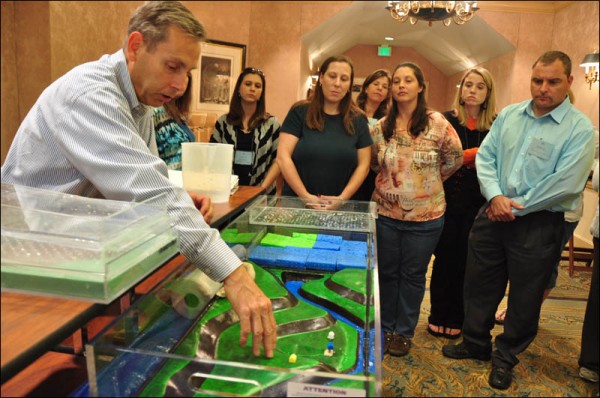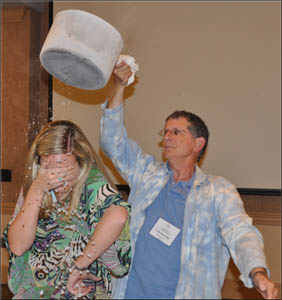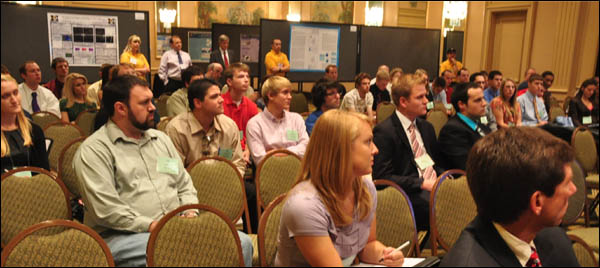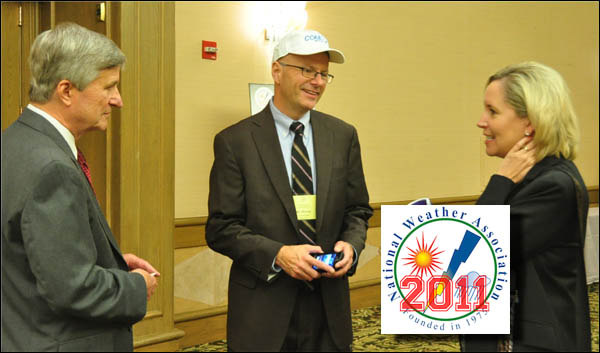NWA 2011: A Volunteer’s Perspective
Trying to select a highlight from this week’s annual meeting of the National Weather Association is sort of like walking into your favorite bakery or doughnut shop and having to pick the treat you want most. Good luck. Pink or chocolate icing? With or without sprinkles? The task may be easier said than done.
There were so many informative presentations and panel discussions. There were so many prominent people from the meteorological, scientific, commercial and broadcast industries, and government, gathering at one spot, unleashing and sharing an incredible amount of knowledge.

Roger McNeil, a meteorologist with the National Weather Service, gives Alabama teachers a lesson in hydrology.
Long before the first speaker ever stepped to the podium, the momentum of this week had been building. WeatherFest, the October 15th gathering of weather experts and the public at McWane Science Center in downtown Birmingham, was one of the catalysts for the success of this week.
WeatherFest’s weather was perfect, the turnout huge, and the enthusiasm tremendous. I saw the excitement in the eyes of young children, many of whom were probably getting a rare chance to be exposed to the sciences. We desperately need more young people pursuing careers in the sciences. Perhaps WeatherFest’s opportunities for such close up, hands-on involvement may have ignited the fire in some of these young minds. Our answer will come years from now.

H. Michael Mogil, a meteorologist and author, shares some fun weather demonstrations with teachers at NWA 2011 in Birmingham
As the NWA meeting itself got underway, it became obvious that the planning and logistical organizational work that started long ago had paid off.
From the next generation of weather satellites to dual polarization radar, from hurricanes to EF5 tornadoes, from ice to severe weather forecasting and research, a diverse array of experts shared thoughts and experiences, discussing what we’ve learned, and—very important—what we still need to learn.
What we still need to learn received heavy emphasis at the meeting because of Alabama’s April 27th severe weather outbreak. With all our sophisticated technology and so much advance notice, experts and non-experts alike ask why so many people had to die that day. It’s not an easy question to answer. But Tuesday’s Town Hall meeting took a serious try at finding answers that may well keep future generations alive.
As a volunteer, NWA was a wonderful experience (I played an extremely small role, about the size of one sprinkle on one of those doughnuts!). Being around so many experts and getting to sit in during this incredible sharing of knowledge was a rare opportunity and one I enjoyed tremendously. It was very educational … and loads of fun.
All of us who were involved in NWA 2011 have our memorable moments from the week of gatherings.
I’ll always treasure getting to help with Sunday’s session of meteorology students, who got tips and mentoring from some of our nation’s most prominent people in science, aerospace, government and broadcasting on how to get a successful career underway.

Meteorology students attending NWA 2011 in Birmingham get advice on how best to get their careers started.
Looking across these students, I realized that the torch is being handed off, right in front of our eyes.
We are watching the next generation of scientists, researchers, forecasters and broadcasters move through a critical chapter in their lives. One of these young men or women may be who makes a startling breakthrough in atmospheric research, teaching us something new about our planet, or who develops a new way of understanding storm structure and behavior. Future mothers, fathers and children may owe their very survival to what these young people wind up accomplishing. And yes, the next James Spann is probably in this group, too (but I didn’t see anyone who had lost their hair—at least not yet!).
Another memory that’s hard to lose is seeing James almost break into tears, as he talks with a group of teachers about the horror of April 27th. It is still too raw to talk about. Too personal.
NWA 2011 was a lot more than just a meeting of weather experts. It was a chance for Birmingham to show its best to people from all across the country and the world. From the comments I heard, the meeting and the Magic City shined nicely.
Meetings that go as successfully as NWA 2011 went don’t just happen. Planning for an event like this takes meticulous attention to the smallest of details (most details are small until overlooked; then they’re not small anymore!). Making NWA 2011 work took a lot of devotion, time and effort. From people in professional careers related to weather to people with no formal connection at all (just a love and passion for weather), a lot of people in our community helped make NWA 2011 a success.
If there’s any one person who deserves credit for pulling off such a wonderful conference, I know of no one who has put in more time and effort than self-admitted weather geek Bill Murray. He certainly didn’t do this for the money.
Bill’s passion for weather is so intense that he began the effort to bring NWA to Birmingham years ago (literally). This week, that work paid off. We should be grateful that we have movers and shakers like Bill in our community. Bill assembled a team of volunteers who helped with making sure events and presentations went off as smoothly as possible.

Birmingham weather historian Bill Murray (center) was the driving force in bringing NWA 2011 to the Magic City.
Birmingham owes Bill a debt of gratitude.
Category: Hodgepodge















